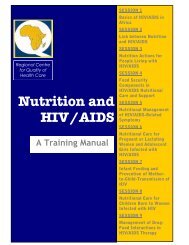2.1: Anthropometric Indicators Measurement Guide - Linkages Project
2.1: Anthropometric Indicators Measurement Guide - Linkages Project
2.1: Anthropometric Indicators Measurement Guide - Linkages Project
You also want an ePaper? Increase the reach of your titles
YUMPU automatically turns print PDFs into web optimized ePapers that Google loves.
REFERENCES PART 9.<br />
Selecting<br />
a Sample<br />
3.<br />
APPENDIX<br />
Sampling is the process that is used to<br />
select a representative group of individuals<br />
whose characteristics can be described and<br />
used to represent the whole population.<br />
The following section outlines a few of the<br />
problems that can result from incorrect<br />
sampling.<br />
Sampling Error<br />
A lot of thought should go into how to<br />
select the sample, and the following<br />
examples illustrate this.<br />
Example: You are interested in doing a<br />
survey that will gather information on the<br />
prevalence of underweight children<br />
between 6 and 35 months and on the<br />
characteristics of their households. Each<br />
village that you will be conducting surveys<br />
in has a clinic where mothers and their<br />
children can be found on certain days of<br />
the week. The clinics already have scales,<br />
which would make them convenient. You<br />
decide to go to the clinics and measure all<br />
the children found there. Is this a good<br />
sampling plan for conducting your survey<br />
The answer is no. Mothers who go to<br />
the clinic are considered self-selecting.<br />
The mothers who decide to go to the clinic<br />
might have reasons for going that would<br />
make them different from mothers who do<br />
not go to the clinic. They might be more<br />
concerned with their child’s health. Or<br />
they might be mothers who have sicker<br />
children. Or they might be mothers who<br />
do not have to work everyday and<br />
therefore have the time to take their<br />
children to the clinic.<br />
Any characteristic that makes an<br />
individual do something may also make<br />
them different from the population as a<br />
whole and have an effect on their<br />
children’s nutritional status. When you<br />
have a sample that is made up of people<br />
who are not representative of the<br />
population for a certain reason, you have<br />
what is called sampling bias. This type of<br />
sampling error can happen when you<br />
select a sample from a group who all go to<br />
a specific place, but it can also happen if<br />
the sample is from one area of a village or<br />
a city or among people who are neighbors.<br />
These individuals may share some<br />
characteristic that makes them more<br />
similar to each other than to the larger<br />
population.<br />
Here are some tips for avoiding this type of<br />
sampling error:<br />
• Do not choose samples exclusively<br />
from particular groups, such as children<br />
coming to clinics.<br />
• Do not ask mothers to bring their<br />
children to a central point in the<br />
community, because some of them will<br />
not come; you will not be able to find out<br />
how many failed to appear and how<br />
different they may be from those who<br />
came.<br />
• Do not use samples chosen at will by<br />
the interviewer, field supervisor or field<br />
director.<br />
9.<br />
69

















